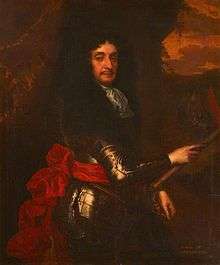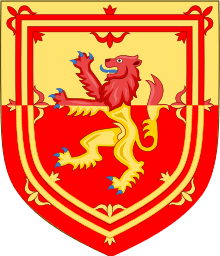John Middleton, 1st Earl of Middleton
| John Middleton 1st Earl of Middleton | |
|---|---|
 | |
| Born | c. 1608 |
| Died |
3 July 1674 (aged 66) Tangier, Morocco |
| Allegiance | Scottish Covenanters - Charles II |

John Middleton, 1st Earl of Middleton (c. 1608 – 3 July 1674) was a Scottish army officer, who belonged to a Kincardineshire family which had held lands at Middleton since the 12th century.
John was born around 1608. He was the eldest son of Robert Middleton of Caldhame and his wife Catherine Strachan; the elder brother of Alexander Middleton and uncle of Alexander's first son George Middleton DD, both of whom served as Principal of King's College, Aberdeen; great uncle of George's son John Middleton (1678–1739); and great-great uncle of Charles Middleton, 1st Baron Barham.[1][2]
Military career
In early life he served as a soldier in France; later he fought against Charles I both in England and in Scotland, being especially prominent at the Battle of Philiphaugh and in other operations against James Graham, 1st Marquess of Montrose.
He held a high command in the Scottish army which marched to rescue the king in 1648, and he was taken prisoner after the Battle of Preston. He joined Charles II when that monarch reached Scotland in 1650, but he was soon at variance with the party which at that time was dominant in church and state and was only restored to favor after doing a public penance at Dundee. He was a captive for the second time after the Battle of Worcester, where he commanded the Royalist cavalry, but he escaped from the Tower of London to Paris.
In 1653, Middleton was chosen by Charles II to head the projected rising in Scotland. He reached Scotland in February 1654, but the insurrection was a complete failure. Its leader, who could not be held responsible for this result, remained in Scotland until 1655, when he rejoined Charles II, who created him Earl of Middleton in 1656.
Political career
Following the Restoration he returned to England with the King in 1660 and was appointed commander-in-chief of the troops in Scotland and Lord High Commissioner to the Parliament of Scotland, which he opened in January 1661. He was an ardent advocate of the restoration of episcopacy, this being one reason which led to serious dissensions between the Earl of Lauderdale and himself, and in 1663 he was deprived of his offices. From 1663 to 1667 he was appointed Governor of Rochester Castle and Lieutenant-General of the Kent militia. In 1667 he was appointed governor of English Tangier on the coast of Morocco, where he died on 3 July 1674.
Family
John Middleton married (contract July 1639), Grizel Durham, who died in September 1666. They had five children together:
- Charles, 2nd Earl of Middleton (1649/1650–1719), married Lady Catherine Brudenell, daughter of Robert Brudenell, 2nd Earl of Cardigan, and Ann Savage, had children
- Lady Grizel Middleton, married William Douglas, 9th Earl of Morton
- Lady Helen Middleton, married Patrick Lyon, 3rd Earl of Strathmore and Kinghorne
- Two daughters, names not known, who both died in 1669
Middleton's second wife was Lady Martha Carey (1635/6–1706), married 16 December 1667 at St. Andrew's, Holborn, daughter of Henry Carey, 2nd Earl of Monmouth and his wife Martha Cranfield. They had two children:
- John Middleton (1668-1696)
- Lady Elizabeth Middleton (1672-1748), married William Spelman
See also
Notes
- ↑ M. R. R. M'Gilchrist Gilchrist, Sir James Balfour Paul ed., The Scots Peerage, volume VI (Edinburgh, 1909) pages 177-180.
- ↑ Bennett, Magnus (28 April 2011). "Royal wedding: Prince William 'has Middleton ancestry'". BBC Scotland news website. BBC. Retrieved 29 April 2011.
References
- Furgol, Edward M. (2004). "Middleton, John, first earl of Middleton (c.1608–1674)". Oxford Dictionary of National Biography (online ed.). Oxford University Press. doi:10.1093/ref:odnb/18674. (Subscription or UK public library membership required.)
- Attribution
-
 This article incorporates text from a publication now in the public domain: Chisholm, Hugh, ed. (1911). "Middleton, Earls of". Encyclopædia Britannica (11th ed.). Cambridge University Press.
This article incorporates text from a publication now in the public domain: Chisholm, Hugh, ed. (1911). "Middleton, Earls of". Encyclopædia Britannica (11th ed.). Cambridge University Press.
Further reading
![]() "Middleton, John (1619-1674)". Dictionary of National Biography. London: Smith, Elder & Co. 1885–1900.
"Middleton, John (1619-1674)". Dictionary of National Biography. London: Smith, Elder & Co. 1885–1900.
| Peerage of Scotland | ||
|---|---|---|
| New creation | Earl of Middleton 1656–1674 |
Succeeded by Charles Middleton |
| Parliament of Scotland | ||
| Preceded by None during the Commonwealth |
Lord High Commissioner 1660–1663 |
Succeeded by The Earl of Rothes |
| Military offices | ||
| Preceded by Henry Norwood |
Colonel of the Tangier Regiment 1668–1674 |
Succeeded by The Earl of Inchiquin |
| Governor of Tangier 1669–1670 (first term) |
Succeeded by Hugh Chomondeley | |
| Preceded by Hugh Chomondeley |
Governor of Tangier 1672–1674 (second term) |
Succeeded by The Earl of Inchiquin |